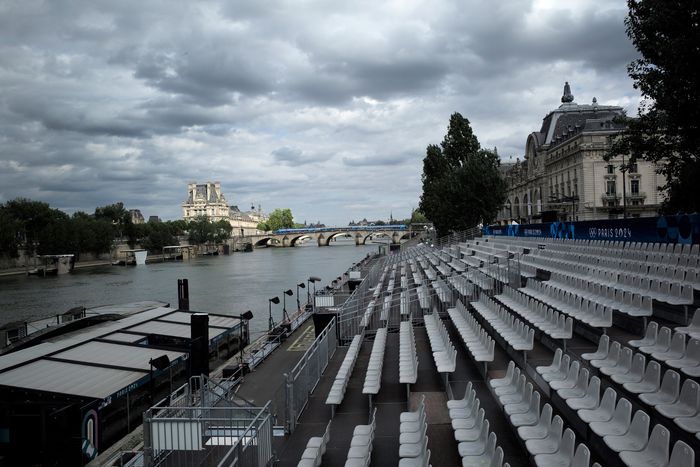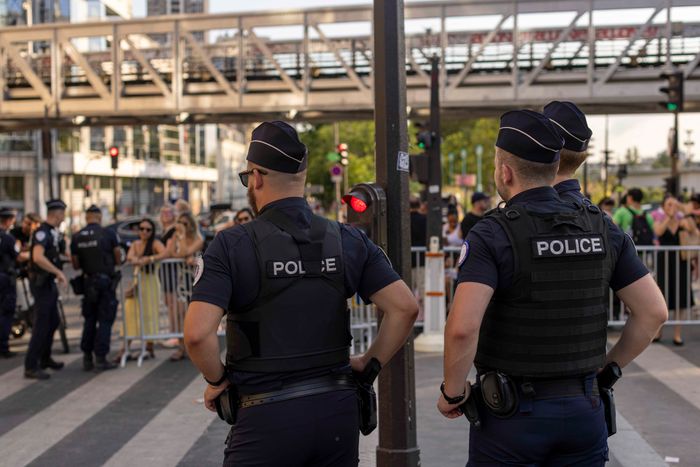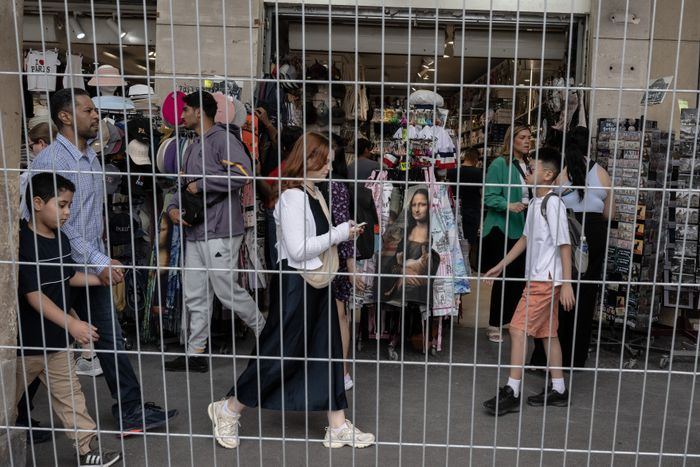The Paris Olympics Have Put the Seine on Lockdown

A French police officer checks QR codes at a checkpoint next to the Seine ahead of the Olympics Opening Ceremony.
Photo: David Ramos/Getty
If you were hoping to get onto Paris’s Île de la Cité — a tiny island on the Seine, home to Notre-Dame and Sainte-Chapelle — you used to be able to simply walk across one of nine bridges to get there. But these days, if you’re on foot, it’s a toss-up. You can gamble on the Petit-Pont-Cardinal-Lustiger, one of the shortest bridges, but you’ll be confined to the sidewalks, which are hemmed in with seven-foot-tall fences. If you’re blocked from crossing at that bridge, you’ll have to get to the next one, Pont Saint-Michel, about a five-minute walk away. But there’s no guarantee you’ll get to cross there either.
Tomorrow, though, might be a different story. The crosswalk that gets you close could be roped off entirely. Same goes for the boulevard leading up to it. The bridge that may have been open yesterday is guarded today by armed officers and some of the 40,000 barricades that have been set up. And if you fail to cross, you’ll quickly be absorbed into one of the countless clusters of people piling up at each road closure, asking police for directions, pulling up their phones to ring someone they can’t get to, and — more than likely — finding another route.
This is the scene leading up to the 2024 Summer Olympics in Paris, which formally begin with the Opening Ceremony Friday night. Sure, it’s a point of pride for this year’s organizers that the Games are really, truly in the city. This means all eyes are on the River Seine. And so the city’s central connective artery, with its 37 bridges linking the Left and Right Banks, is now the heart of the Sécurité Intérieure et Lutte Contre le Terrorisme, or SILT, internal counterterrorism areas codified by law in recent years. It sets up color-coded “perimeters” with varying restrictions that cover all but four crossings. The area spanning the edges along the Seine is “gray” ahead of the Opening Ceremony, which permits mostly Olympic employees and ticket holders to enter after being patted down and searched. And the roads leading up to it are “red,” where traffic of all kinds is heavily regulated.
The stands along the Seine for the public to view the Opening Ceremony taking place in the river.
Photo: Antoine Gyori/Corbis/Getty/Corbis via Getty Images
The Seine’s SILT zones are where the ceremony route (and a lot of the events) will take place, with a first-ever floating parade that culminates in a modular stadium at Champ-de-Mars, in front of the Eiffel Tower. It’s why the waterway’s cleanliness has become Emmanuel Macron’s obsession, a $1.5 billion project that some citizens find objectionably costly, with Mayor Anne Hidalgo’s test dive last week meant to prove its game-readiness. But in the city known for the flâneur, where strolls along the Seine are a standard bit in nearly every film, Impressionist painting, and tote bag of Paris, the security apparatus of 45,000 police officers, 10,000 soldiers, and 20,000 additional private-security hires hovering near every access point has made getting around the city arduous and unpredictable.
There is something to be said for a centralized, urban Games: When I reported from the 2016 Summer Games in Rio de Janeiro, all the matches were far from the city center; that left many Brazilians feeling shut out. But it also placed little pressure on their regular routes and routines. To make a decidedly urban Olympics work, with the 10 million-plus visitors expected, France has deployed the largest military presence since World War II — a dramatic spike in the post-Bataclan security Parisians have grown used to. (And still shocking, even to a New Yorker who regularly encounters the National Guard in his subway system.) Frustrated residents and shop owners say the situation reminds them off COVID-era lockdowns, even if the stakes today are infinitely lower.
Police guarding the security parameter around the Seine on July 20.
Photo: Maja Hitij/Getty/Getty Images
People walking along the perimeter of the Seine are hemmed in by seven-foot-tall fencing.
Photo: David Ramos/Getty
There are a few work-arounds. One of the hottest commodities in Paris right now is a QR code that proves you have a valid reason to enter some part of the SILT: a proof of residence, a medical appointment, a work obligation, or the like. (Nearly 300,000 people — mostly Parisians — have signed up already.) Outside of manning barricades, police officers spend most of their time scanning these codes. For those able to procure one, passage is easier to come by. But for everyone else (tourists, residents not in the know, anyone else hoping their hyperspecific excuse suffices), you’re not given much leeway, even if it’s to get to a café that you can literally see through the mesh fencing you’re pinned behind. (Speaking French doesn’t open any doors, either.) It’s common to see a driver frantically waving a paper from their window, or a family at a café arguing about whether they have any pretext for a QR code to enter that part of town. Unable to roam freely, locals and tourists alike are finally unified in their daily bewilderment and frustration.
If all else fails, a bike was made for this moment. The road closures have emptied the streets near the Seine of cars, opening up space for two-wheelers. The work Hidalgo has done to make Paris “100 percent cyclable” and the envy of urbanists these last few years has meant that cyclists are the street’s VIPs, with protected, well-marked routes almost everywhere. There are now 60 kilometers of new bike lanes and 10,000 bike parking spaces near the Olympic venues. The city’s Vélib bike-share system added 3,000 more cycles to its fleet for the occasion, and dockless e-bikes (serviced by Lime, Dott, and Tier) are as abundant as café seating at this point. It doesn’t mean bikers are automatically waved through, but they have more space to move on the roads and can pivot to alternatives, while pedestrians and cars might get stuck in bottlenecks and checkpoints. After failing to get across the Seine multiple times the other day, a friend asked a police officer where he could cross. “Try a few bridges over,” he said, and, on our Lime bikes, we were quickly able to test his suggestion. We ended up on Pont Notre-Dame with the bridge to ourselves and our only other company, emergency vehicles. Pedestrians, meanwhile, were claustrophobically fenced in on the sidewalk, trying to get where they were going. They looked so cooped up that my partner described it as “worse than the Eras tour.”
As for navigating around, Google Maps remains a sea of red dots indicating all the choke points along the Seine. I mostly rely on CityMapper, an app that has updated information on routes to avoid Olympic closures and highlights access points, which has made it slightly less confusing to walk around.
But most Parisians I know have chosen to avoid the Seine altogether. If they suggest a bar or café, it’s far from there. (Some texts to meet have come attached with QR-code guidance.) When a friend biking to work was stopped by officers on his normal route to the office, he gave up — and took the Métro.







